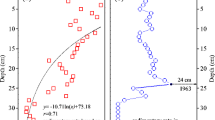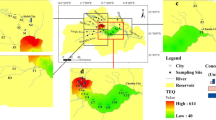Abstract
Thirty-five surface sediment samples collected from three mangroves in Shantou coastal zone, China in 2007 were analyzed for a suite of polycyclic aromatic hydrocarbons (PAHs). Two mathematical models were used to determine the profiles and relative contributions of PAH sources to the mangroves. The two models are principal component analyses (PCA) with multiple linear regression analysis (MLR) and positive matrix factorization (PMF). Both models identified five factors and gave excellent correlation coefficients between predicted and measured levels of 16 PAH compounds, but the results had some differences. The PAH contribution rate attributed to vehicular emission sources identified by PCA-MLR was 37.20%, but the rate identified by PMF was only 12.37%. The main sources identified by PCA-MLR were combination of biomass/coal combustion and vehicular emissions, whereas the main source identified by PMF was only biomass/coal combustion. The PMF analysis was the preferred model for the paper data set.






Similar content being viewed by others
References
Abdi, H. 2003. Factor rotations in factor analyses. In Encyclopedia of social sciences research methods, ed. M. Lewis-Beck, A. Bryman, and T. Futing. Thousand Oaks: Sage.
Almeida, S.M., C.A. Pio, M.C. Freitas, M.A. Reis, and M.A. Trancoso. 2006. Approaching PM (2.5) and PM (2.5−10) source apportionment by mass balance analysis, principal component analysis and particle size distribution. Science of the Total Environment 368: 663–674.
Anttila, P., P. Paatero, U. Tapper, and O. Jarvinen. 1995. Source identification of bulk wet deposition in Finland by positive matrix factorization. Atmospheric Environment 29: 1705–1718.
Bi, X., Y. Feng, J. Wu, Y. Wang, and T. Zhu. 2007. Source apportionment of PM10 in six cities of northern China. Atmospheric Environment 21: 903–912.
Brown, S.G., A. Frankel, and H.R. Hafner. 2007. Source apportionment of VOCs in the Los Angeles area using positive matrix factorization. Atmospheric Environment 41: 227–237.
Bruno, P., M. Caselli, G. de Gennaro, and A. Traini. 2001. Source apportionment of gaseous atmospheric pollutants by means of an absolute principal component scores (APCS) receptor model. Freseniuś Journal of Analytical Chemistry 371: 1119–1123.
Budzinski, H., I. Jones, J. Bellocq, C. Pierard, and P. Garrigues. 1997. Evaluation of sediment contamination by polycyclic aromatic hydrocarbons in the Gironde estuary. Marine Chemistry 58: 85–97.
Bzdusek, P.A., J. Lu, and E.R. Christensen. 2006. PCB congeners and dechlorination in sediments of Sheboygan River, Wisconsin, determined by matrix factorization. Environmental Science and Technology 40: 1120–1129.
Chen, Y.J., G.Y. Sheng, X.H. Bi, and J.M. Fu. 2005. Emission factors for carbonaceous particles and polycyclic aromatic hydrocarbons from residential coal combustion in China. Environmental Science and Technology 39: 1861–1867.
Christensen, E.R., and P.A. Bzdusek. 2005. PAHs in sediments of the Black River and the Ashtabula River, Ohio: source apportionment by factor analysis. Water Research 39: 511–524.
Dou, H., B. Chang, C.Z. Wei, W.X. Qiu, S.Z. Liu, Y. Liu, W.X. Liu, and S. Tao. 2007. Emission factors of PAHs in residential coal combustion in China. Acta Scientiae Circumstantiae 27: 1783–1788.
Fang, G.C., Y.S. Wu, C.N. Chang, and T.T. Ho. 2006. A study of polycyclic aromatic hydrocarbons concentrations and source identifications by methods of diagnostic ratio and principal component analysis at Taichung chemical Harbor near Taiwan Strait. Chemosphere 64: 1233–1242.
Gschwend, P.M., and R.A. Hites. 1981. Fluxes of polycyclic aromatic hydrocarbons to marine and lacustrine sediments in the northeastern United States. Geochimica et Cosmochimica Acta 45: 2395–2367.
Guo, H., T. Wang, and P.K. Louie. 2004. Source apportionment of ambient non-methane hydrocarbons in Hong Kong: application of a principal component analysis/absolute principal component scores (PCA/APCS) receptor model. Environmental Pollution 129(489–4): 98.
Harrison, R.M., D.J.T. Smith, and L. Luhana. 1996. Source apportionment of atmospheric polycyclic aromatic hydrocarbons collected from an urban location in Birmingham, U.K. Environmental Science and Technology 30: 825–832.
Hopke, P. 1985. Receptor modeling in environmental chemistry. New York: Wiley-Interscience.
Jenkins, B.M., A.D. Jones, S.Q. Turn, and R.B. Williams. 1996. Emission factors for polycyclic aromatic hydrocarbons from biomass burning. Environmental Science and Technology 30: 2462–2469.
Keeler, G.J., M.S. Landis, G. Norris, E.M. Christianson, and J.T. Dvonch. 2006. Source of mercury wet deposition in Eastern Ohio, USA. Environmental Science and Technology 40: 5874–5881.
Khalili, N.R., P.A. Scheff, and T.M. Holsen. 1995. PAH source fingerprints for coke ovens, diesel and gasoline engines, highway tunnels, and wood combustion emissions. Atmospheric Environment 29: 533–542.
Kim, M., S.R. Deshpande, and C. Crist. 2007. Source apportionment of fine particulate matter (PM2.5) at a rural Ohio River Valley site. Atmospheric Environment 41: 9231–9234.
Kulkarni, P., and C. Venkataraman. 2000. Atmospheric polycyclic aromatic hydrocarbons in Mumbai, India. Atmospheric Environment 34: 2785–2790.
Kumata, H., M. Uchida, E. Sakuma, T. Uchida, K. Fujiwara, M. Tsuzuki, M. Youneda, and Y. Shibata. 2006. Compound class specific 14C analysis of polycyclic aromatic hydrocarbons associated with PM10 and PM1.1 aerosols from residential areas of suburban Tokyo. Environmental Science and Technology 40: 3474–3480.
Larsen 3rd, R.K., and J.E. Baker. 2003. Source apportionment of polycyclic aromatic hydrocarbons in the urban atmosphere: a comparison of three methods. Environmental Science and Technology 37: 1873–1881.
Lee, P.K., J.R. Brook, E. Dabek-Zlotorzynska, and S.A. Mabury. 2003. Identification of the major sources contributing to PM2.5 observed in Toronto. Environmental Science and Technology 37: 4831–4840.
Lee, R.G.M., P. Coleman, J.L. Jones, and R. Lohmann. 2005. Emission factors and importance of PCDD/Fs, PCBs, PCNs, PAHs, and PM10 from the domestic burning of coal and wood in the U.K. Environmental Science and Technology 39: 1436–1447.
Lin, P. 1990. In Mangrove research papers (I), ed. P. Lin, 1. China: Xiamen University Press.
Mandalakis, M., O. Gustafsson, T. Alsberg, A.L. Egeback, C.M. Reddy, L. Xu, J. Klanova, I. Holoubek, and E.G. Stephanou. 2005. Contribution of biomass burning to atmospheric polycyclic aromatic hydrocarbons at three European background sites. Environmental Science and Technology 39: 2976–2982.
Motelay-Massei, A., T. Harner, M. Shoeib, M. Diamond, G. Stern, and B. Rosenberg. 2005. Using passive air samplers to assess urban–rural trends for persistent organic pollutants and polycyclic aromatic hydrocarbons. 2. Seasonal trends for PAHs, PCBs, and organochlorine pesticides. Environmental Science and Technology 39: 5763–5773.
Norris, G, R. Vedantham, K. S. Wade, S. G. Brown, J. D. Prouty, and C. Foley. 2008. EPA positive matrix factorization (PMF) 3.0 fundamentals and user guide. Prepared for the U.S. Environmental Protection Agency, Washington, D.C., by the National Exposure Research Laboratory, Research Triangle Park, Sonoma Technology, Inc., Petaluma, CA, and Lockheed Martin Systems Engineering Center, Arlington, VA, EP-D-05-004; STI-907045.05-3347-UG, October.
Paatero, P. 1997. Least squares formulation of robust non-negative factor analysis. Chemometric and Intelligent Laboratory Systems 37: 23–35.
Paatero, P. 1999. The multilinear engine: a table-driven, least squares program for solving multilinear problems, including the n-way parallel factor analysis model. Journal of Computational and Graphical Statistics 8: 854–888.
Paatero, P., and U. Tapper. 1993. Analysis of different modes of factor analysis as least squares fit problems. Chemometric and Intelligent Laboratory Systems 18: 183–194.
Paatero, P., and U. Tapper. 1994. Positive matrix factorization: a non-negative factor model with optimal utilization of error estimates of data values. Environmetrics 5: 111–126.
Philip, R.P. 2007. The emergence of stable isotopes in environmental and forensic geochemistry studies: A review. Environmental Chemistry Letters 5: 57–66.
Pio, C.A., C.A. Alves, and A.C. Duarte. 2001. Identification, abundance and origin of atmospheric organic particulate matter in a Portuguese rural area. Atmospheric Environment 35: 1365–1375.
Poirot, R.L., P.R. Wishinski, P.K. Hopke, and A.V. Polissar. 2001. Comparative application of multiple receptor methods to identify aerosol sources in northern vermont. Environmental Science and Technology 35: 4622–4636.
Polissar, A.V., P. Paatero, P.K. Hopke, W.C. Malm, and J.F. Sisler. 1998. Atmospheric aerosol over Alaska 2. Elemental composition and sources. Journal of Geophysical Research 103: 19045–19057.
Ramadan, Z., B. Eickhout, X. Song, L.M.C. Buydens, and P.K. Hopke. 2003. Comparison of positive matrix factorization and multilinear engine for the source apportionment of particulate pollutants. Chemometric and Intelligent Laboratory Systems 66: 15–28.
Reinikainen, S.P., P. Laine, P. Minkkinen, and P. Paatero. 2001. Factor analytical study on water quality in Lake Saimaa, Finland. Freseniuś Journal of Analytical Chemistry 369: 727–732.
Sicre, M.A., J.C. Marty, A. Saliot, X. Aparicio, J. Grimalt, and J. Alebaigés. 1987. Aliphatic and aromatic hydrocarbons in different sized aerosols over the Mediterranean Sea: occurrence and origin. Atmospheric Environment 21: 2247–2259.
Simcik, M.F., S.J. Eisenreich, and P.J. Lioy. 1999. Source apportionment and source/sink relationships of PAHs in the coastal atmosphere of Chicago and Lake Michigan. Atmospheric Environment 33: 5071–5079.
Soclo, H.H., P. Garrigues, and M. Eward. 2000. Origin of polycyclic aromatic hydrocarbons (PAHs) in coastal marine sediments: case studies in Cotonou (Benin) and Aquitaine (France) areas. Marine Pollution Bulletin 40: 387–396.
Sofowote, U.M., B.E. McCarry, and C.H. Marvin. 2008. Source apportionment of pAH in Hamilton Harbour suspended sediments: comparison of two factor analysis methods. Environmental Science and Technology 42: 6007–6014.
Song, Y., Y.H. Zhang, S.D. Xie, L.M. Zeng, M. Zheng, L.G. Salmon, M. Shao, and S. Slanina. 2006. Source apportionment of PM2.5 in Beijing by positive matrix factorization. Atmospheric Environment 40: 1526–1537.
Sporstol, S., N. Gjos, R.G. Lichtenthaler, K.O. Gustavsen, K. Urdal, F. Oreld, and J. Skei. 1983. Source identification of aromatic hydrocarbons in sediments using GC/MS. Environmental Science and Technology 17: 282–286.
Tam, N.F.Y., L. Ke, X.H. Wang, and Y.S. Wong. 2001. Contamination of polycyclic aromatic hydrocarbons in surface sediments of mangrove swamps. Environmental Pollution 114: 255–263.
Vaccaro, S., E. Sobiecka, S. Contini, G. Locoro, G. Free, and B.M. Gawlik. 2007. The application of positive matrix factorization in the analysis, characterization and detection of contaminated soils. Chemosphere 69: 1055–1063.
Wang, Z., J. Chen, X. Qiao, P. Yang, F. Tian, and L. Huang. 2007. Distribution and sources of polycyclic aromatic hydrocarbons from urban to rural soils: a case study in Dalian, China. Chemosphere 68: 965–971.
Yunker, M.B., R.W. Macdonald, R. Vingarzan, R.H. Mitchell, D. Goyette, and S. Sylvestre. 2002. PAHs in the Fraser River basin: a critical appraisal of PAH ratios as indicators of PAH source and composition. Organic Geochemistry 33: 489–515.
Zhou, L., E. Kim, P.K. Hopke, C.O. Stanier, and S. Pandis. 2004. Advanced factor analysis on pittsburgh particle size-distribution data. Aerosol Science and Technology 38: 118–132.
Acknowledgments
Funding for this project was provided through UNEP/GEF Reversing Environmental Degradation Trends in South China Sea and Gulf of Thailand (UNEP/GEF GF/3010-07-03).
Author information
Authors and Affiliations
Corresponding author
Rights and permissions
About this article
Cite this article
Cao, Q., Wang, H. & Chen, G. Source Apportionment of PAHs Using Two Mathematical Models for Mangrove Sediments in Shantou Coastal Zone, China. Estuaries and Coasts 34, 950–960 (2011). https://doi.org/10.1007/s12237-011-9397-3
Received:
Accepted:
Published:
Issue Date:
DOI: https://doi.org/10.1007/s12237-011-9397-3




